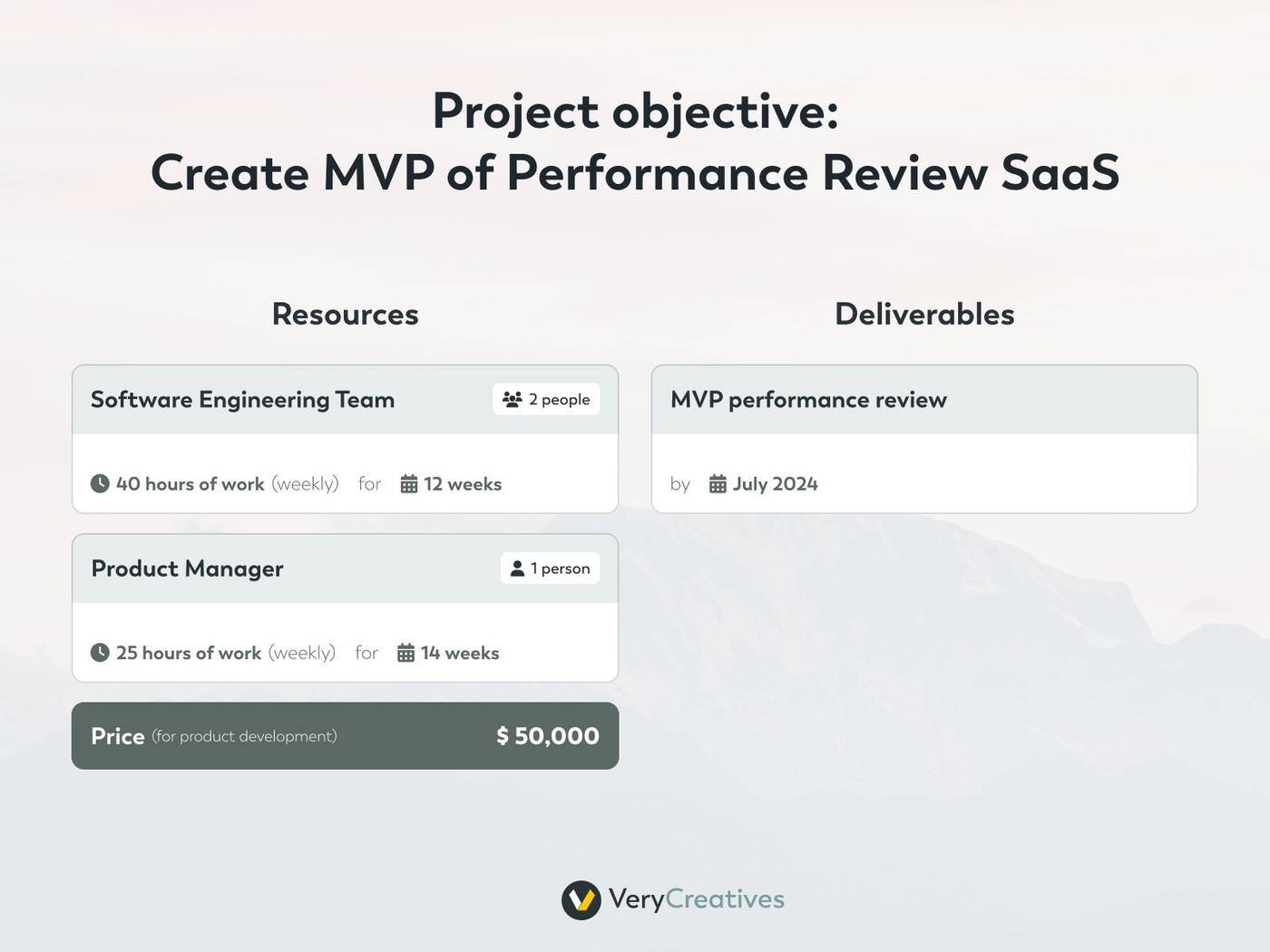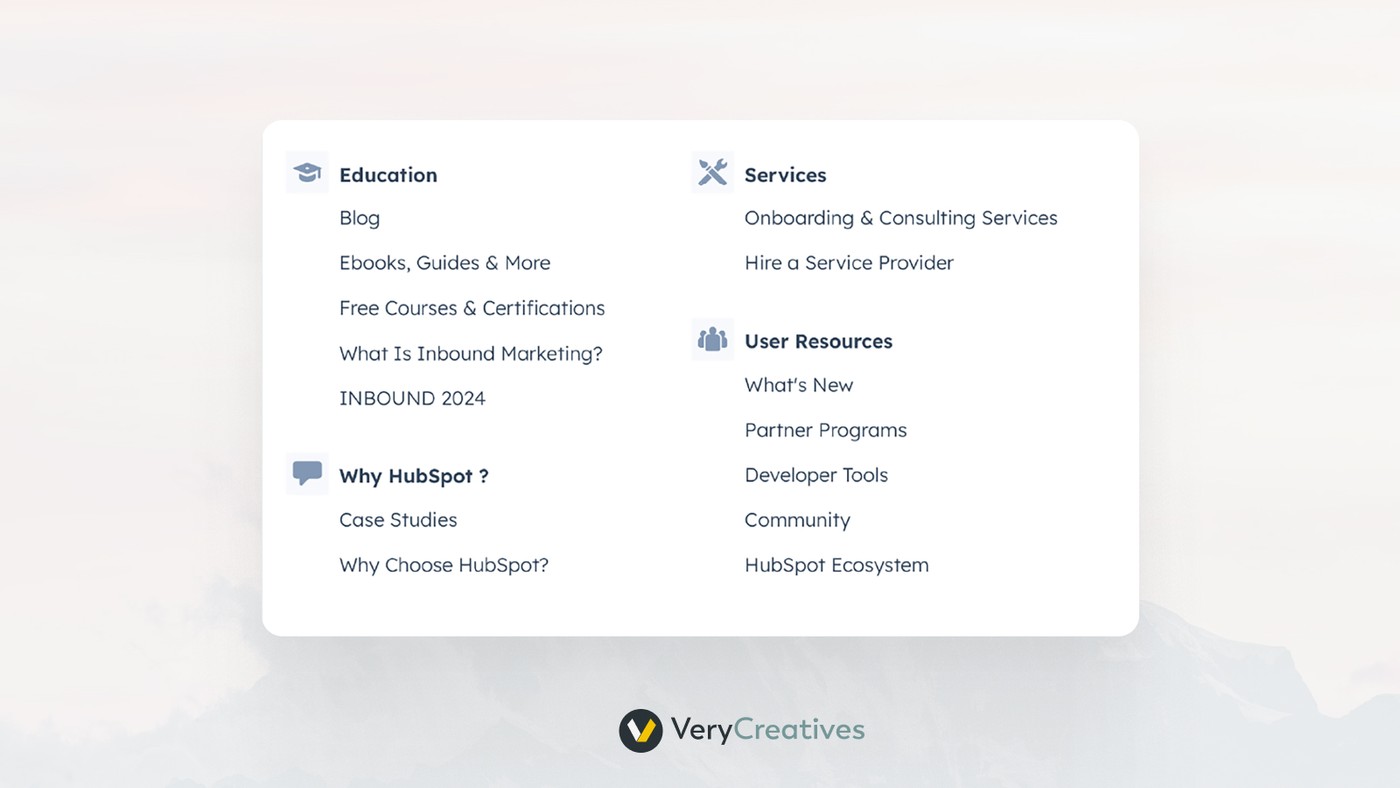You know what a nightmare scope creep is if you have any experience in scoping a SaaS. It results in missed deadlines, extra work for your team, and a decent chunk of your project budget going to waste.
If you want to escape this state, you have to prepare upfront. After working with 100+ SaaS companies, we uncovered 7 most common mistakes in SaaS project scoping.
In this article, we’ll reveal those mistakes, help you address them, and decrease your scope creep risk significantly.
Understanding the Importance of Accurate SaaS Project Scoping
Your SaaS project scope outlines the components of your project, including your resources and deliverables. Here’s an example project scope for a SaaS performance review software

es. Here’s an example project scope for a SaaS performance review software
This project scope statement is a blueprint for the project. It states the goals of the project, what resources are allocated for it, and its deadline. It simplifies the entire project.
Every manager’s dream is to complete a project A to Z without delays, changes,or extra costs but that rarely happens. In fact only 51% of projects are completed on time, and only 57% don’t exceed their budgets.
These delays and changes are caused by multiple reasons, such as poor communication, underestimating your project’s complexity, or not devoting enough resources. Another problem could be your managers adding more features mid-development than initially agreed upon.
Unnecessary changes and delays compromise your project’s quality and negatively impact the confidence of your stakeholders, including customers and team members.
The solution is to build an accurate project scope.
A project scope breaks down your project into manageable milestones you can share with your team. An accurate project scope also clarifies your and your stakeholders’ expectations from the project.
The keyword is accurate. An accurate project scope correctly estimates the time and resources needed to finish a project.
Say your project scope states you need $10,000 and one year to finish a project. Your project scope was accurate if you finished it within this budget and timeline
Building an accurate project scope means making informed decisions on which features to include, what deadlines to set, and which resources to use. Only then, can you keep your team accountable for the project.
An inaccurate project scope has the opposite of its intended effect. Suppose your project requirements underestimate the time or resources you need. Say you want to build a SaaS in a year. If you underestimate the resources needed, you could take a year and a half instead.
This will lead to the loss of resources and might hinder your SaaS growth at early stages.
An inaccurate scope of work can cause your project to fail before it even starts. Here are seven mistakes you should look out for from Day 1:
Mistake 1: Underestimating User Engagement Needs
Involve user feedback to ensure your project scope reflects user needs. End-users are stakeholders in your project, so you need their input to satisfy their needs.
Don’t assume what your users want. Your assumptions may not be accurate. You’ll likely have to make changes later if you continue a project with unvalidated assumptions. These changes will cost you time, money, and resources. You might also successfully build a project users don’t want.
Take Google Wave, for example. Google released it in 2009 as a collaborative work–platform that would replace email. It completely failed and was discontinued only 3 years later.
Google built Wave with an unvalidated assumption during scoping that users would leave email. They didn’t. Google misunderstood their user’s needs and didn’t include their input during their scoping workshop.
Slack also wanted to replace email. But unlike Google, they prioritized user engagement during scoping. They learned that users didn’t need a replacement for email. So they couldn’t replace it, but they also learned something else.
Users did want a centralized workplace communication tool. So Slack pivoted their product to provide that instead of replacing email. If Google included user engagement during scoping, they might’ve arrived at the same conclusion as Slack.
Mistake 2: Overlooking Market Research and Competition Analysis
Use market research to ensure your project aligns with market demands. And use competition analysis to discover how to differentiate your project. Your goal is to contextualize your project’s value against the market and your competitors.
Without doing this, you can’t validate your project’s value with stakeholders. That’s because you have no evidence that your project can succeed in the market. You also need both market research and competition analysis in conjunction to be effective.
Use market research to identify market demands. Suppose you discover demand for your project. You now know the market wants what your product provides. But without a competition analysis, you won’t know why users should choose your product over alternatives.
You need the competition analysis to identify those features that give your product a USP. Without that, your entire project scope could be inaccurate.You may end up incorporating unwanted features while neglecting the ones users truly desire. Plus, you increase your chances for scope creep.
Zoom is the best example of how competition analysis avoids scope creep. Zoom used their market research to identify high demand for a video communications platform. Their competition analysis further revealed their competitors did not provide user friendly platforms for small businesses.
Zoom used these findings at their product strategy workshop to include features that made their product user friendly for small business requirements. Doing this at the scoping phase prevented them from having to change their product later.
Mistake 3: Neglecting Financial Metrics and Pricing Strategies
You need to consider the financial aspect of your project while scoping. Your financial metrics include the resources you allocate for your project. And your pricing strategy reveals your project’s feasibility to your stakeholders.
Neglecting either hurts your project. Overestimate your project’s financial needs, and you’ll overspend and suffer scope creep. Underestimate your project’s needs, and you may not even complete it. You want to invest the appropriate amount, i.e enough to complete your project at the lowest cost.
Use financial metrics, including expected marginal recurring revenue(MRR), average recurring revenue (ARR), and cost estimations to determine how much to invest. Suppose you need 3 Python developers for a year. The average U.S Python developer earns $114,000 annually. So you can estimate a labor cost of $342,000 for your 3 developers for a year.
Your project’s pricing strategy also impacts your project direction since it impacts your project’s financial feasibility.
Your pricing strategy determines your project’s feasibility for stakeholders. It tells them how your project will make the revenue needed to justify it. It’s also your financial justification for which features you should include and why you should even complete the project.
For example, Paddle is a SaaS that provides B2B revenue growth management. Paddle determined the best pricing strategy for them was a usage-based pricing model.
Paddle learned that their intended customers preferred a usage-based model to avoid unnecessary costs. They also learned that few competitors provided this model. So they designed their product from the start to offer usage-based pricing.
Their pricing model established their product’s feasibility with their stakeholders because it explained how Paddle could be financially successful.
Mistake 4: Failing to Plan for Scalability and Future Growth
Scalability in SaaS is successfully providing your service to a growing user-base. The SaaS business model depends on scalability to maximize revenue.
You want new users to access your product right after they purchase a subscription. Doing so improves your reputation, maximizes revenue, and satisfies new users.
Plan for scalability and growth from the start. For instance, you can use cloud-based architecture to ensure you always have enough storage space to add new users.
You might experience increased interest from potential users. But without being able to onboard them successfully, your SaaS won’t benefit from increased interest system crashes and downtime. hurt your reputation, lead to revenue loss, and hurt customer experience.
Not accounting for growth during scoping also carries other risks.
An example of a SaaS that included scalability in its project scope is SalesForce. SalesForce designed its product to be scalable and flexible from the start. They achieved this using Oracle databases to store their data.
This allowed them to accommodate an increasingly large user base. SalesForce focused on growing their user base instead of worrying about how to accommodate growth. That’s a major reason why they successfully grew their product and are reputed for high-quality service.
Mistake 5: Overlooking the Need for Comprehensive Training and Support
67% of SaaS customers cancel their subscriptions due to negative customer support experiences. That means even if your product is otherwise high-quality, users will leave without adequate support. So don’t assume that all you need to do is complete the project and the market will sell it.
You need to actively provide customer support and training from day one to retain users. Otherwise, new users will quickly leave your product. And you’ll need to constantly acquire new users to compensate for the revenue loss of previous users.
Depending on your product’s complexity, users might need time and training. Figure out how to provide training and support at the scoping stage. Otherwise, you’ll suffer unnecessary user attrition once you launch your product.
Provide customer support at the scoping stage by building a knowledge base, manuals, and designing your SaaS to offer in-app support.
An example of a SaaS that successfully achieved this is HubSpot.
HubSpot prioritized customer training at their project scope. These include HubSpot Academy, HubSpot Community, and the HubSpot Blog.

HubSpot uses these tools to provide high quality customer service and training. Their customer-centric approach is a major contributor to their company’s success.
Mistake 6: Misaligning Customer Success and Sales Goals
A SaaS business can increase profitability by up to 95% by improving customer retention by 5%. That’s because acquiring new customers is costlier than retaining existing ones. You maximize your product’s profitability when you retain as many of your existing customers while acquiring new ones.
To achieve both goals, i.e. retain existing customers and gain new ones, you need to align your customer success and sales teams as they are the most responsible for both areas. Every user first interacts with your sales team during the sales process. They then interact with your customer success team after subscribing to your SaaS. You want the transition experience between your sales and customer success team to be smooth to prevent dissatisfaction. That way you’ll maximize retention.
Misalignment between sales and customer success impacts your project scope. Your project’s feasibility depends on being financially successful. Adopting a customer-first approach ensures you’ll minimize user attrition, which increases stakeholder confidence.
You can align your sales and customer success team through these strategies:
- Build and share customer profiles between your customer success and sales teams.
- Create a defined transition process from sales to customer success.
- Encourage your sales and customer success teams to collaborate.
These strategies bridge the gap between your sales and customer success teams and keep them aligned.
An example of a business that’s achieved this is Zendesk. Zendesk has a customer-centric approach. It involves collaboration between their sales and customer success teams. For example, they have a defined transitioning process from sales to customers, which minimizes customer dissatisfaction.
Summary
Your project scope outlines your project’s objective, deliverables, and deadline. An accurate project scope reduces scope creep and helps you smoothly finish your project.
To arrange a productive scope session, you need to account for everything from market research to pricing strategy.
Without this info, your scoping projects will become confusing. This will do more harm than good.
If you need some help to define the scope of your projects, book a call with VeryCreatives today, and we’ll be there for you!